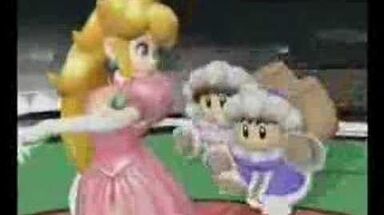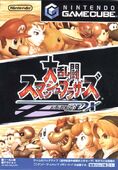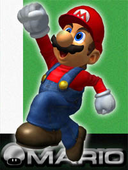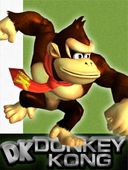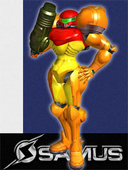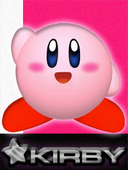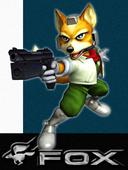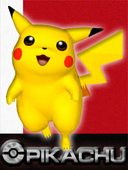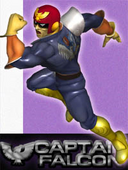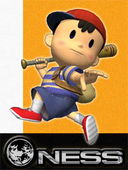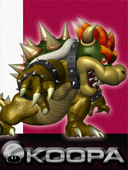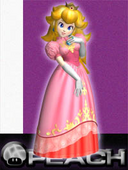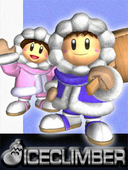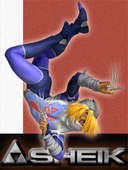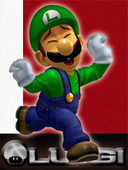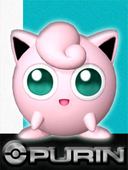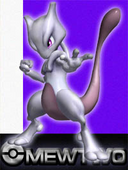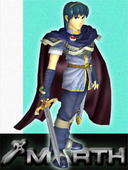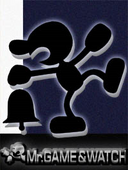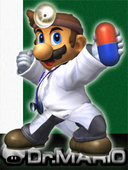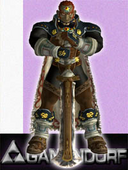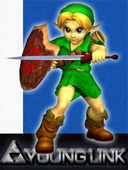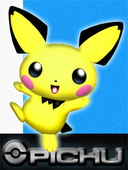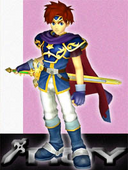(Hope this works) |
(grammatical fixes) |
||
| (28 intermediate revisions by 19 users not shown) | |||
| Line 14: | Line 14: | ||
|requirements = 11 blocks of memory (an additional 2 or more blocks are needed for each snapshot saved) |
|requirements = 11 blocks of memory (an additional 2 or more blocks are needed for each snapshot saved) |
||
}} |
}} |
||
| − | '''''Super Smash Bros. Melee''''' ({{ja|大乱闘 スマッシュ ブラザーズ DX|Dairantō Sumasshu Burazāzu Derakkusu}}, ''Great Fray Smash Brothers Deluxe''), often shortened to '''''SSBM''''' or '''''Melee''''', is a 2.5D fighting game for the [[Nintendo GameCube]]. It was first released on November 21, 2001 in Japan, shortly after the GameCube's launch, on December 3, 2001 in North America, and finally in May 2002 in Europe and Australia. It is the second game in the series, following ''[[Super Smash Bros.]]'' |
+ | '''''Super Smash Bros. Melee''''' ({{ja|大乱闘 スマッシュ ブラザーズ DX|Dairantō Sumasshu Burazāzu Derakkusu}}, ''Great Fray Smash Brothers Deluxe''), often shortened to '''''SSBM''''' or '''''Melee''''', is a 2.5D fighting game for the [[Nintendo GameCube]]. It was first released on November 21, 2001, in Japan, shortly after the GameCube's launch, on December 3, 2001 in North America, and finally in May 2002 in Europe and Australia. It is the second game in the series, following ''[[Super Smash Bros.]]'' |
Like [[Super Smash Bros.|its predecessor]], ''Melee'' features [[gameplay]] unique in comparison to that of other fighting games. Characters have simple movesets that lack complicated button inputs and lengthy inescapable combos, instead emphasizing movement and ringouts. The game features many character appearances based on, but not identical to, their appearances in games from the Nintendo 64. |
Like [[Super Smash Bros.|its predecessor]], ''Melee'' features [[gameplay]] unique in comparison to that of other fighting games. Characters have simple movesets that lack complicated button inputs and lengthy inescapable combos, instead emphasizing movement and ringouts. The game features many character appearances based on, but not identical to, their appearances in games from the Nintendo 64. |
||
| Line 27: | Line 27: | ||
===Playable Characters=== |
===Playable Characters=== |
||
{|class="wikitable" style="text-align:center;margin:1em auto 1em auto;" |
{|class="wikitable" style="text-align:center;margin:1em auto 1em auto;" |
||
| − | !colspan=6|Veterans |
+ | ! colspan="6" |Veterans (12) |
|- |
|- |
||
|-style="vertical-align:bottom" |
|-style="vertical-align:bottom" |
||
| Line 44: | Line 44: | ||
|[[File:Nessmeleeclear.png|link=Ness (SSBM)|100px]]<br/>[[Ness (SSBM)|Ness]]<br/>{{symbol|earthbound|20px|suffix=preBrawl}} |
|[[File:Nessmeleeclear.png|link=Ness (SSBM)|100px]]<br/>[[Ness (SSBM)|Ness]]<br/>{{symbol|earthbound|20px|suffix=preBrawl}} |
||
|- |
|- |
||
| − | !colspan=6|Newcomers |
+ | ! colspan="6" |Newcomers (14) |
|-style="vertical-align:bottom" |
|-style="vertical-align:bottom" |
||
|[[File:Peachmeleeclear.png|link=Peach (SSBM)|100px]]<br/>[[Peach (SSBM)|Peach]]<br/>{{symbol|mario|20px|suffix=preBrawl}} |
|[[File:Peachmeleeclear.png|link=Peach (SSBM)|100px]]<br/>[[Peach (SSBM)|Peach]]<br/>{{symbol|mario|20px|suffix=preBrawl}} |
||
| Line 128: | Line 128: | ||
===Single-Player stages=== |
===Single-Player stages=== |
||
These stages cannot be unlocked, and can only be played under certain circumstances (or if the game is hacked). |
These stages cannot be unlocked, and can only be played under certain circumstances (or if the game is hacked). |
||
| − | *[[Target Test |
+ | *[[Target Test|Target Test Stages]] |
*[[Trophy Collector]] |
*[[Trophy Collector]] |
||
*[[Race to the Finish (SSBM)|Race to the Finish]] |
*[[Race to the Finish (SSBM)|Race to the Finish]] |
||
| Line 146: | Line 146: | ||
====Functional==== |
====Functional==== |
||
*[[Test (stage)|Test]] |
*[[Test (stage)|Test]] |
||
| − | *Zelda/Sheik's |
+ | *Zelda/Sheik's Target Test Stage |
====Non-Functional==== |
====Non-Functional==== |
||
| Line 156: | Line 156: | ||
==Voices== |
==Voices== |
||
| − | *Dean Harrington as Announcer, Master Hand and Crazy Hand |
+ | *Dean Harrington as Announcer, Master Hand, and Crazy Hand |
| − | *Charles Martinet as Mario, Luigi and Dr. Mario |
+ | *Charles Martinet as Mario, Luigi, and Dr. Mario |
*Nobuyuki Hiyama as Link |
*Nobuyuki Hiyama as Link |
||
*Kazumi Totaka as Yoshi |
*Kazumi Totaka as Yoshi |
||
| Line 185: | Line 185: | ||
==Modes== |
==Modes== |
||
| − | [[File:Mode Select - Super Smash Bros. Melee.png|thumb| |
+ | [[File:Mode Select - Super Smash Bros. Melee.png|thumb|224x224px|The main menu screen for the game.]] |
===1-P Mode=== |
===1-P Mode=== |
||
*[[Classic Mode]] |
*[[Classic Mode]] |
||
| Line 216: | Line 216: | ||
==Unlockables== |
==Unlockables== |
||
| − | The game features several points to be unlocked, most of which include the [[Trophy|trophies]], unlockable characters and stages. Some of them are unlocked by a special way, like achieving a certain distance on the [[Home-Run Contest]], while others are obtained by the [[Lottery]]. For a full list, see [[Complete Melee Unlockables]]. |
+ | The game features several points to be unlocked, most of which include the [[Trophy|trophies]], unlockable characters, and stages. Some of them are unlocked by a special way, like achieving a certain distance on the [[Home-Run Contest]], while others are obtained by the [[Lottery]]. For a full list, see [[Complete Melee Unlockables]]. |
== Changes from [[Super Smash Bros]]. == |
== Changes from [[Super Smash Bros]]. == |
||
| Line 228: | Line 228: | ||
*The amount of [[flinch|hitstun]] a character suffers has been slightly decreased. |
*The amount of [[flinch|hitstun]] a character suffers has been slightly decreased. |
||
*The single-player [[Board the Platforms]] bonus game does not return. It was replaced with [[Snag the Trophies]]. |
*The single-player [[Board the Platforms]] bonus game does not return. It was replaced with [[Snag the Trophies]]. |
||
| − | *[[Air dodging]], moonwalking, and [[Sidestepping|sidestep dodging]] have been implemented. |
+ | *Directional [[Air dodging]], moonwalking, and [[Sidestepping|sidestep dodging]] have been implemented. |
*All characters can move while carrying a heavy item (albeit very slowly); in the original, this ability was exclusive to [[Donkey Kong]]. Donkey Kong is the fastest carrier, of course. |
*All characters can move while carrying a heavy item (albeit very slowly); in the original, this ability was exclusive to [[Donkey Kong]]. Donkey Kong is the fastest carrier, of course. |
||
| − | *Most spikes are now [[Meteor Smash]] |
+ | *Most spikes are now [[Meteor Smash|Meteor Smashes]] and all have been changed to be slightly harder to perform. (All characters' Meteor Smashes now have starting lag, unlike the original) |
*Wall jumping has been implemented for some characters. |
*Wall jumping has been implemented for some characters. |
||
*Wall Teching has been implemented. |
*Wall Teching has been implemented. |
||
*Certain characters can now wall grapple using their [[Tether Recovery]]. |
*Certain characters can now wall grapple using their [[Tether Recovery]]. |
||
*Items can now be grabbed before coming to a complete stop; they can also be grabbed by a character in midair. |
*Items can now be grabbed before coming to a complete stop; they can also be grabbed by a character in midair. |
||
| − | *[[Smash Attack]] |
+ | *[[Smash Attack|Smash Attacks]] can now be charged by holding the A button. |
| − | *[[Smash Attack]] |
+ | *[[Smash Attack|Smash Attacks]] can now be executed immediately with the C-Stick. This only works in VS Mode. |
| − | *The [[Heart Container |
+ | *The [[Heart Container|Heart Container's]] healing power has been reduced to simply healing '''100%''', while the[[Maxim Tomato| Maxim Tomato's]] effect was also reduced to '''50%'''. |
*On-Screen Appearances have been removed, focusing more on the game's concept of trophies coming to life. |
*On-Screen Appearances have been removed, focusing more on the game's concept of trophies coming to life. |
||
*There is a selection of time for stocks. |
*There is a selection of time for stocks. |
||
| Line 246: | Line 246: | ||
*New [[Adventure Mode]]. |
*New [[Adventure Mode]]. |
||
*All characters can Dash Grab. |
*All characters can Dash Grab. |
||
| + | *All of the characters' extra alternate costumes, previously exclusive to Team Battles in ''Super Smash Bros.'', can now be used in regular battle. |
||
==Trivia== |
==Trivia== |
||
*''Super Smash Bros. Melee ''was the inspiration for [[amiibo]] in ''[[Super Smash Bros. for Nintendo 3DS and Wii U]].'' |
*''Super Smash Bros. Melee ''was the inspiration for [[amiibo]] in ''[[Super Smash Bros. for Nintendo 3DS and Wii U]].'' |
||
| − | *In ''Super Smash Bros. Brawl'', one of the names that |
+ | *In ''Super Smash Bros. Brawl'', one of the names that appear when the players press the "Random Name" button when naming their custom stage is '''MELEE''', a reference to this game. |
*In the debug menu, there is a stage named "IceTop", which freezes the game when selected. It is possible that the [[Summit]] stage was planned to appear in ''Melee'' under that name. |
*In the debug menu, there is a stage named "IceTop", which freezes the game when selected. It is possible that the [[Summit]] stage was planned to appear in ''Melee'' under that name. |
||
*In Classic Mode, for some unknown reason, the player never fights against [[Ganondorf]] or [[Roy]]. Also, the player only fights [[Mr. Game & Watch]] in the multi-man battle. |
*In Classic Mode, for some unknown reason, the player never fights against [[Ganondorf]] or [[Roy]]. Also, the player only fights [[Mr. Game & Watch]] in the multi-man battle. |
||
**Ganondorf appears only as a teammate in Classic Mode, while Roy never appears at all as a CPU player. Also, Zelda is never a teammate for the player in that game mode. |
**Ganondorf appears only as a teammate in Classic Mode, while Roy never appears at all as a CPU player. Also, Zelda is never a teammate for the player in that game mode. |
||
| − | *In the Spanish version of ''Paper Mario: The Thousand-Year Door'', one of |
+ | *In the Spanish version of ''Paper Mario: The Thousand-Year Door'', one of Rawk Hawk's lines is slightly changed to "¡Los aficionadillos deberían quedarse en casa jugando ''Super Smash Bros. Melee''!" (translation: "The weaklings should stay home playing ''Super Smash Bros. Melee''!") after having defeated The Koopinator. In all other versions of the game "''Super Smash Bros. Melee''" is simply replaced with "video games". |
| − | *''Super Smash Bros. Melee'' is the first in its franchise to be rated T by the ESRB, |
+ | *''Super Smash Bros. Melee'' is the first in its franchise to be rated T by the ESRB, and also the first game that almost any of the series' characters in the game (Fire Emblem is the only exception) have appeared in a T-rated game. |
*All playable characters made their first playable Gamecube appearance in this game except for Luigi, who was first playable earlier in ''[[Luigi's Mansion]]'' before ''Melee''. |
*All playable characters made their first playable Gamecube appearance in this game except for Luigi, who was first playable earlier in ''[[Luigi's Mansion]]'' before ''Melee''. |
||
*This is the first and only Smash Bros. game with no battle entrances. |
*This is the first and only Smash Bros. game with no battle entrances. |
||
| Line 261: | Line 262: | ||
*The music for the main menu has many similarities to "Bowser's Road" from ''[[Super Mario 64]]''. |
*The music for the main menu has many similarities to "Bowser's Road" from ''[[Super Mario 64]]''. |
||
*[[Masahiro Sakurai]] has stated that he wanted to implement 8-Player Smash into a Smash Bros. game since Melee, but due to the hardware limitations of the Nintendo GameCube, he was unable to do this. 8-Player Smash was eventually implemented into [[Super Smash Bros. for Wii U]]. |
*[[Masahiro Sakurai]] has stated that he wanted to implement 8-Player Smash into a Smash Bros. game since Melee, but due to the hardware limitations of the Nintendo GameCube, he was unable to do this. 8-Player Smash was eventually implemented into [[Super Smash Bros. for Wii U]]. |
||
| − | *Frank Welker, who was the voice of both Bowsers was in |
+ | *Frank Welker, who was the voice of both Bowsers, was in many cartoons: Scooby-Doo, The Simpsons, etc. |
*Exactly 13 years later, the North American version of ''Super Smash Bros. for Wii U'' was released on Nov. 21, 2014 similar to ''Super Smash Bros. Melee's ''Japanese release on Nov. 21, 2001. |
*Exactly 13 years later, the North American version of ''Super Smash Bros. for Wii U'' was released on Nov. 21, 2014 similar to ''Super Smash Bros. Melee's ''Japanese release on Nov. 21, 2001. |
||
*This game is internally known as '''''Smash 2'''''. |
*This game is internally known as '''''Smash 2'''''. |
||
| Line 269: | Line 270: | ||
==Gallery== |
==Gallery== |
||
| − | <center><gallery widths="170" bordercolor="#ffffff"> |
+ | <center><gallery widths="170" bordercolor="#ffffff" orientation="none"> |
File:Meleelogo.png|The logo for ''Super Smash Bros. Melee''. |
File:Meleelogo.png|The logo for ''Super Smash Bros. Melee''. |
||
Super_Smash_Bros._Melee_-_North_American_Boxart.png|North America cover art |
Super_Smash_Bros._Melee_-_North_American_Boxart.png|North America cover art |
||
| Line 301: | Line 302: | ||
Pichu SSBM.png|Pichu |
Pichu SSBM.png|Pichu |
||
Roy SSBM.png|Roy |
Roy SSBM.png|Roy |
||
| + | 723A8D24-611F-41B7-B7BD-1978F3B85A9C.png|Japanese Title screen |
||
</gallery></center> |
</gallery></center> |
||
Revision as of 01:52, 20 September 2020
Super Smash Bros. Melee (大乱闘 スマッシュ ブラザーズ DX, Great Fray Smash Brothers Deluxe), often shortened to SSBM or Melee, is a 2.5D fighting game for the Nintendo GameCube. It was first released on November 21, 2001, in Japan, shortly after the GameCube's launch, on December 3, 2001 in North America, and finally in May 2002 in Europe and Australia. It is the second game in the series, following Super Smash Bros.
Like its predecessor, Melee features gameplay unique in comparison to that of other fighting games. Characters have simple movesets that lack complicated button inputs and lengthy inescapable combos, instead emphasizing movement and ringouts. The game features many character appearances based on, but not identical to, their appearances in games from the Nintendo 64.
Intro
Fighters
There are 26 playable characters in the entire game, 12 veterans and 14 newcomers. There are fifteen starter characters and eleven more which can be unlocked. While the original twelve characters have returned from the original game, only ten are available from the start.
Playable Characters
| Veterans (12) | |||||
|---|---|---|---|---|---|
 Mario |
 Luigi |
 Yoshi |
 Donkey Kong |
 Link |
 Samus |
 Kirby |
 Fox |
 Pikachu |
 Jigglypuff |
 Captain Falcon |
 Ness |
| Newcomers (14) | |||||
 Peach |
 Bowser |
 Dr. Mario |
 Zelda |
 Sheik |
 Ganondorf |
 Young Link |
 Falco |
 Mewtwo |
 Pichu |
 Ice Climbers |
 Mr. Game & Watch |
 Marth |
 Roy |
||||
Non-Playable Characters
Master Hand (Except by the Name Entry glitch or Action Replay)
Crazy Hand* (Except by Action Replay)
Giga Bowser* (Except by Action Replay)
Male Wireframe* (Except by Action Replay)
Female Wireframe* (Except by Action Replay)
Sandbag* (Except by Action Replay)
Solo Ice Climber (Can only be played via debug menu, or in the Target Test; Action Replay)*
Stages
There are eighteen starter stages and eleven more which can be unlocked.
Bold denotes unlockable stages.
Single-Player stages
These stages cannot be unlocked, and can only be played under certain circumstances (or if the game is hacked).
- Target Test Stages
- Trophy Collector
- Race to the Finish
- Mushroom Kingdom Adventure
- Underground Maze
- Brinstar Escape Shaft
- F-Zero Grand Prix
- Rest Station
- Home-Run Stadium
- Goomba
- Entei
- Majora's Mask
Debug-Only Stages
These stages can only be used when the game is hacked. Some are functional, most are not.
Functional
- Test
- Zelda/Sheik's Target Test Stage
Non-Functional
* Can be activated with other hacks, but not Debug Mode.
Voices
- Dean Harrington as Announcer, Master Hand, and Crazy Hand
- Charles Martinet as Mario, Luigi, and Dr. Mario
- Nobuyuki Hiyama as Link
- Kazumi Totaka as Yoshi
- Frank Welker as Bowser and Giga Bowser
- Shinobu Satouchi as Fox McCloud
- Makiko Ômoto as Kirby and Ness
- Ikue Ohtani as Pikachu
- Rachael Lillis as Jigglypuff
- Jen Taylor as Princess Peach
- Ryô Horikawa as Captain Falcon
- Jun Mizusawa as Zelda and Shiek
- Hikaru Midorikawa as Marth
- Sanae Kobayashi as Popo and Nana
- Jun Fukuyama as Roy
- Takashi Nagasako as Donkey Kong and Ganondorf
- Masachika Ichimura as Mewtwo
- Satomi Kōrogi as Pichu
- Fujiko Takimoto as Young Link
- Hisao Egawa as Falco Lombardi
- Chris Seavor as Peppy Hare and Slippy Toad
- Steve Malpass as Fox McCloud
- Ben Cullum as Falco Lombardi
- James W. Norwood Jr. as DK Rap Performance
- Tara Sands as Clefairy
- Eric Staurt as Weezing and Blastoise
- Kôichi Yamadera as Mew
Modes
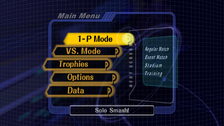
The main menu screen for the game.
1-P Mode
- Classic Mode
- Adventure Mode
- All-Star Mode (must be unlocked)
- Event Match
- Stadium
- Training
Vs. Mode
Action Replay
Unlockables
The game features several points to be unlocked, most of which include the trophies, unlockable characters, and stages. Some of them are unlocked by a special way, like achieving a certain distance on the Home-Run Contest, while others are obtained by the Lottery. For a full list, see Complete Melee Unlockables.
Changes from Super Smash Bros.
While Super Smash Bros. Melee mainly follows the same formula introduced in the original game by retaining most elements, several differences exist between the two games. The following list, while not all-inclusive, addresses several of the changes. Please note that this list does not include obvious changes, such as a different button scheme/controller and Melee-only characters and items.
- All characters have four special moves; veterans now have new Side Special Moves. In some cases (such as Link and Ness), the character's old Standard Special got moved to their Side Special, with the newly added move becoming the Neutral Special.
- The number of throws each character can perform has also been increased to four; all veterans now have an Up Throw and a Down Throw. Some Forward or Back Throws have been changed to a character's Up or Down Throw (Kirby's Forward Throw in Super Smash Bros., for example, is his Up Throw in this game). A majority of the throws themselves have been decreased significantly in power and knockback, though some are great for comboing.
- While grabbing, characters can now pummel the opponent.
- Characters can escape from the grab.
- The pacing of the game has been increased.
- The amount of hitstun a character suffers has been slightly decreased.
- The single-player Board the Platforms bonus game does not return. It was replaced with Snag the Trophies.
- Directional Air dodging, moonwalking, and sidestep dodging have been implemented.
- All characters can move while carrying a heavy item (albeit very slowly); in the original, this ability was exclusive to Donkey Kong. Donkey Kong is the fastest carrier, of course.
- Most spikes are now Meteor Smashes and all have been changed to be slightly harder to perform. (All characters' Meteor Smashes now have starting lag, unlike the original)
- Wall jumping has been implemented for some characters.
- Wall Teching has been implemented.
- Certain characters can now wall grapple using their Tether Recovery.
- Items can now be grabbed before coming to a complete stop; they can also be grabbed by a character in midair.
- Smash Attacks can now be charged by holding the A button.
- Smash Attacks can now be executed immediately with the C-Stick. This only works in VS Mode.
- The Heart Container's healing power has been reduced to simply healing 100%, while the Maxim Tomato's effect was also reduced to 50%.
- On-Screen Appearances have been removed, focusing more on the game's concept of trophies coming to life.
- There is a selection of time for stocks.
- If one ends a game early, the statistics won't be saved.
- The angle at which the menus are seen can be tilted with the C-stick. Also, the player can press L or R to view another fighter when the game is paused.
- If a container is broken, an enemy from the Mario, Zelda, or Ice Climber series might pop out. The chances of this are slim. This is the only game in the series to have this feature.
- 1P Game has been replaced with Classic Mode.
- New Adventure Mode.
- All characters can Dash Grab.
- All of the characters' extra alternate costumes, previously exclusive to Team Battles in Super Smash Bros., can now be used in regular battle.
Trivia
- Super Smash Bros. Melee was the inspiration for amiibo in Super Smash Bros. for Nintendo 3DS and Wii U.
- In Super Smash Bros. Brawl, one of the names that appear when the players press the "Random Name" button when naming their custom stage is MELEE, a reference to this game.
- In the debug menu, there is a stage named "IceTop", which freezes the game when selected. It is possible that the Summit stage was planned to appear in Melee under that name.
- In Classic Mode, for some unknown reason, the player never fights against Ganondorf or Roy. Also, the player only fights Mr. Game & Watch in the multi-man battle.
- Ganondorf appears only as a teammate in Classic Mode, while Roy never appears at all as a CPU player. Also, Zelda is never a teammate for the player in that game mode.
- In the Spanish version of Paper Mario: The Thousand-Year Door, one of Rawk Hawk's lines is slightly changed to "¡Los aficionadillos deberían quedarse en casa jugando Super Smash Bros. Melee!" (translation: "The weaklings should stay home playing Super Smash Bros. Melee!") after having defeated The Koopinator. In all other versions of the game "Super Smash Bros. Melee" is simply replaced with "video games".
- Super Smash Bros. Melee is the first in its franchise to be rated T by the ESRB, and also the first game that almost any of the series' characters in the game (Fire Emblem is the only exception) have appeared in a T-rated game.
- All playable characters made their first playable Gamecube appearance in this game except for Luigi, who was first playable earlier in Luigi's Mansion before Melee.
- This is the first and only Smash Bros. game with no battle entrances.
- Super Smash Bros. Melee is the first game in the franchise in which Ness and Captain Falcon are playable from the start. In Super Smash Bros. and Super Smash Bros. Brawl, both of these characters are unlockable.
- In Super Smash Bros. for Nintendo 3DS and Wii U however, they are both available from the start once again.
- The music for the main menu has many similarities to "Bowser's Road" from Super Mario 64.
- Masahiro Sakurai has stated that he wanted to implement 8-Player Smash into a Smash Bros. game since Melee, but due to the hardware limitations of the Nintendo GameCube, he was unable to do this. 8-Player Smash was eventually implemented into Super Smash Bros. for Wii U.
- Frank Welker, who was the voice of both Bowsers, was in many cartoons: Scooby-Doo, The Simpsons, etc.
- Exactly 13 years later, the North American version of Super Smash Bros. for Wii U was released on Nov. 21, 2014 similar to Super Smash Bros. Melee's Japanese release on Nov. 21, 2001.
- This game is internally known as Smash 2.
Trailers
Gallery
External links
| |||||


